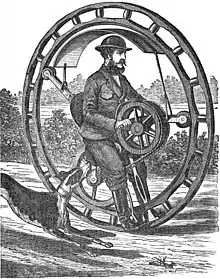Electric unicycle
An electric unicycle (‘EUC,’ sometimes pronounced 'yuke') is a self-balancing personal transporter with a single wheel. The rider controls speed by leaning forwards or backwards, and steers by leaning and twisting the unit side to side with their feet. The self-balancing mechanism uses gyroscopes and accelerometers.

Operation
Most commercial units are self-balancing in the direction of travel only (single axis) with lateral stability being provided by the rider; more complex fully self-balancing dual-axis devices also need to self-balance from side to side. The control mechanisms of both use control moment gyroscopes, reaction wheels and/or auxiliary pendulums and can be considered to be inverted pendulum.
History

Early experimentation
- See also Monowheel
A hand-power monowheel was patented in 1869 by Richard C. Hemming[1] with a pedal-power unit patented in 1885.[2] Various motorized monowheels were developed and demonstrated during the 1930s without commercial success[3] and Charles F Taylor was granted a patent for a "vehicle having a single supporting and driving wheel" in 1964 after some 25 years of experimentation.[4]
Commercialisation
In 2003, Bombardier announced a conceptual design for such a device used as a sport vehicle, the Embrio.[5] In September 2004 Trevor Blackwell demonstrated a functional self-balancing unicycle, using the control-mechanism similar to that used by the Segway PT and published the designs as the Eunicycle. In 2008 RYNO Motors demonstrated their prototype unit.[6] In January 2009 Focus Designs demonstrates electric unicycle to Segway inventor.[7] In March 2010 Shane Chen of Inventist filed a patent application for a seatless electric unicycle (associated with the "Solowheel" product launched in February 2011).[8] In Oct 2010 Focus Designs published a video of an electric unicycle with hub motor and a seat.[9] Late in 2015, the Ford Motor Company patented a "self-propelled unicycle engagable with vehicle", intended for last-mile commuters.[10]

By the turn of the decade, several Chinese manufacturers dominate the market and continue to release EUC models with higher top speeds (above 65 km/h or 40 mph),[11] and longer range batteries.
Suspension
In chronological order, the following suspension-models were announced/ came out:-
Popular culture
- A self-balancing unicycle was described in 1969 in The Man From R.O.B.O.T., a short story by science fiction author Harry Harrison.[15]
Gallery
Companies
- Begode (previously known as Gotway)[16]
- Guangzhou Veteran Intelligent Technology [17][18]
- InMotion Technologies Co[19]
- Inventist Inc[20]
- Kingsong Intell Tech Co[21]
- Ninebot Limited[22][23]
See also
- Ballbot, a mobile robot designed to balance on a single spherical wheel
- Honda U3-X, which looks like a self-balancing unicycle, but balances on a powered Omni wheel
- Inertia wheel pendulum
- Onewheel, a sort of electric skateboard
- RIOT wheel, a ridable single-axis self-balancing unicycle with an unusually low centre of gravity, with its rider in front of, rather than on top of its single wheel
- Uno, a sort of dicycle
References
- Improvement in velocipede, 1869
- US Patent 325,548
- "One-wheeled motorcycles: As cool as they are wildly dangerous". Wired. 24 March 2014.
- US Patent 3,145,797
- "Hot Wheel". Forbes.
- "A brief history of the RYNO". RYNO.
- "SBU meet the Segway | Self-Balancing Unicycle | Focus Designs, Inc". focusdesigns.com. Retrieved 2018-10-07.
- "Solowheel self-balancing unicycle is as easy to ride as it is to afford". Wngadget. 2011-02-11.
- focusdesigns (2010-10-11), Self Balancing Unicycle (SBU) V2.0, retrieved 2018-10-07
- Read, Richard (December 29, 2015). "Ford Patent Could Transform Your Car Into A Unicycle". The Car Connection. Internet Brns Automotive Group. Retrieved 10 September 2016.
- "Know this before buying a Veteran Sherman Electric Unicycle". oneradwheel.com. Retrieved 2020-11-15.
- S18 Suspension Test. Kuji Rolls. Apr 10, 2020. Retrieved 2020-12-16
- "New 31 mph and 3,000W electric unicycle announced with true suspension". electrek.co. Apr 14, 2020. Retrieved 2020-11-15.
- The Suspension Trinity is Complete. evX. Oct 19, 2020. Retrieved 2020-12-16
- ANALOG — Science Fiction/Science Fact, Vol. LXXXIII, No. 5, July 1969, pp. 120-151. Illustrations by Peter Skirka.
- https://www.kebye.com/
- https://medium.com/@shanewhilde/what-we-know-about-the-veteran-sherman-electric-unicycle-591db2d4a70a
- http://www.leaperkim.com/
- https://www.inmotionworld.com/company/who-we-are
- Solowheel
- https://ecodrift.by/2020/03/12/about-king-song/
- http://no-en.segway.com/about-us-(1)
- https://www.ninebot.cn/
Further reading
- Research papers (in reverse date order)
- Wu, Junfeng; Zhang, Wanying; Wang, Shengda (26 November 2012). "A Two-Wheeled Self-Balancing Robot with the Fuzzy PD Control Method". Mathematical Problems in Engineering. 2012: 1–13. doi:10.1155/2012/469491.
- Tomašić, Tomislav; Demetlika, Andrea; Crneković, Mladen (2012). "Self-balancing mobile robot tilter". 36 (3). Transactions of FAMENA: 23. Archived from the original on 2014-02-09. Cite journal requires
|journal=(help) - Ruan, Jian-Wei Zhao; Xiao-Gang (1 September 2011). "Modelling and Control of a Flexible Two-Wheeled Self-Balancing Mobile Robot". International Journal of Systems, Control and Communications. 3 (3): 330–355. doi:10.1504/IJSCC.2011.042438.
- Ben S. Cazzolato, David Keith Caldecott, Andrew John Edwards, Matthew Anthony Haynes, Miroslav Jerbic, Andrew Christopher Kadis and Rhys James J. Madigan Micycle - A Self-Balancing Unicycle, University of Adelaide, 2010
- Johnson, R.C. (2002). "Unicycles and bifurcations" (PDF). American Journal of Physics. 66 (7): 589–92. CiteSeerX 10.1.1.693.5310. doi:10.1119/1.19027.
- Zenkov, DV; Bloch, AM; Marsden, JE (2001). "The Lyapunov-Malkin Theorem and Stabilization of the Unicycle with Rider". Systems and Control Letters. 45 (4): 293–302. doi:10.1016/s0167-6911(01)00187-6.
- Zenkov, DV; Bloch, AM; Leonard, NE; Marsden, JE (2000). "Matching and Stabilization of Low-dimensional Nonholonomic Systems" (PDF). Proc. CDC. 39: 1289–1295. Archived from the original (PDF) on 2003-06-27.
- Ulyanov, S. V.; et al. (1998). "Soft computing for the intelligent robust control of a robotic unicycle with a new physical measure for mechanical controllability". Soft Computing. 2 (2): 73–88. doi:10.1007/s005000050036. S2CID 17955504.
- Sheng, Zaiquan; Yamafuji, Kazuo (1995). Realization of a Human Riding a Unicycle by a Robot. Proceedings of the 1995 IEEE International Conference on Robotics and Automation. 2. pp. 1319–1326. doi:10.1109/ROBOT.1995.526027. ISBN 978-0-7803-1965-3. S2CID 7280130.
- A. Schoonwinkel, Design and test of a computer stabilized unicycle Ph.D. dissertation, Stanford University, California, 1987
| Wikimedia Commons has media related to Self-balancing unicycles. |
- Other
- Flexible two-wheeled self-balancing mobile robot, 9th IFAC Symposium on Robot Control (2009)



